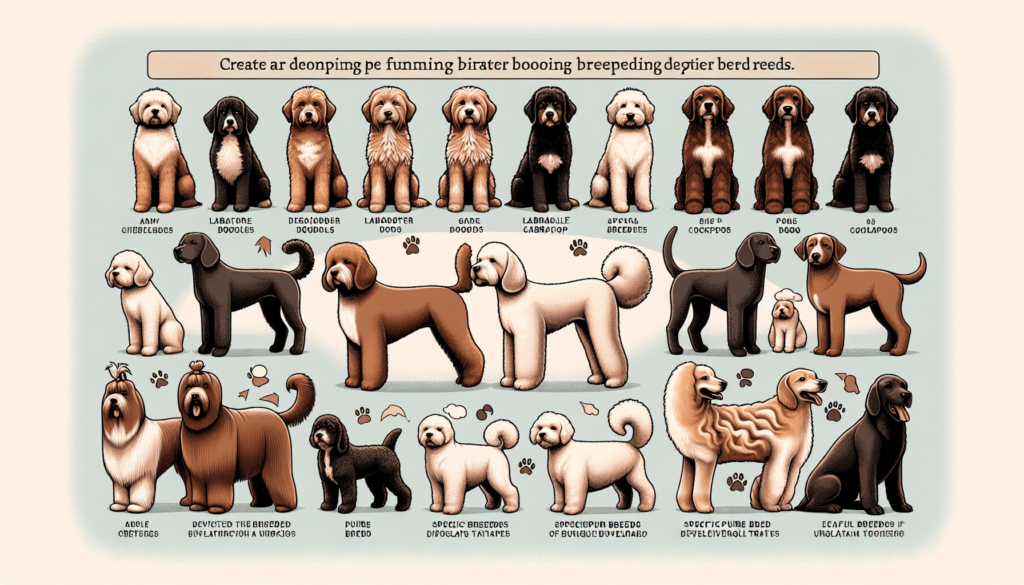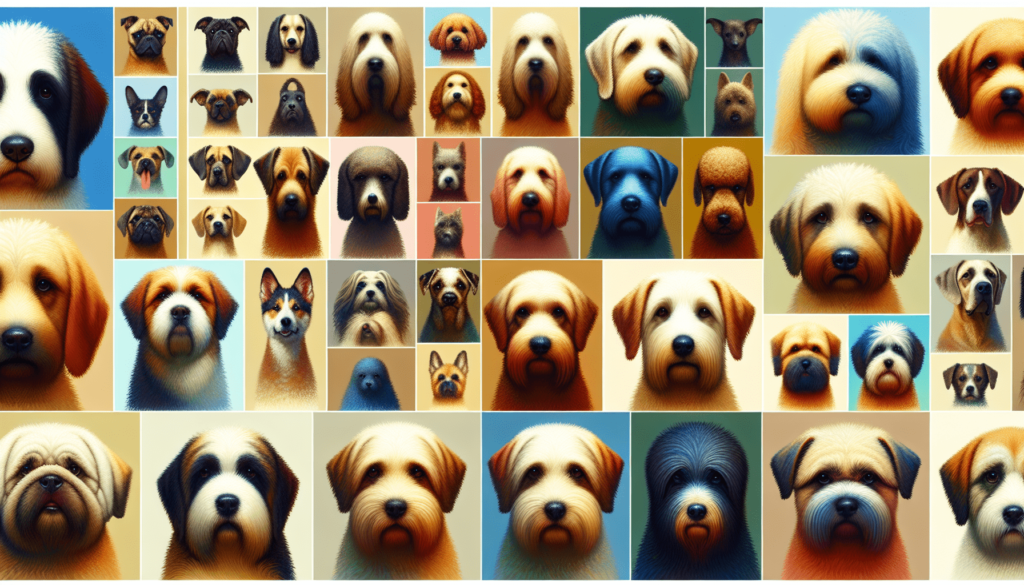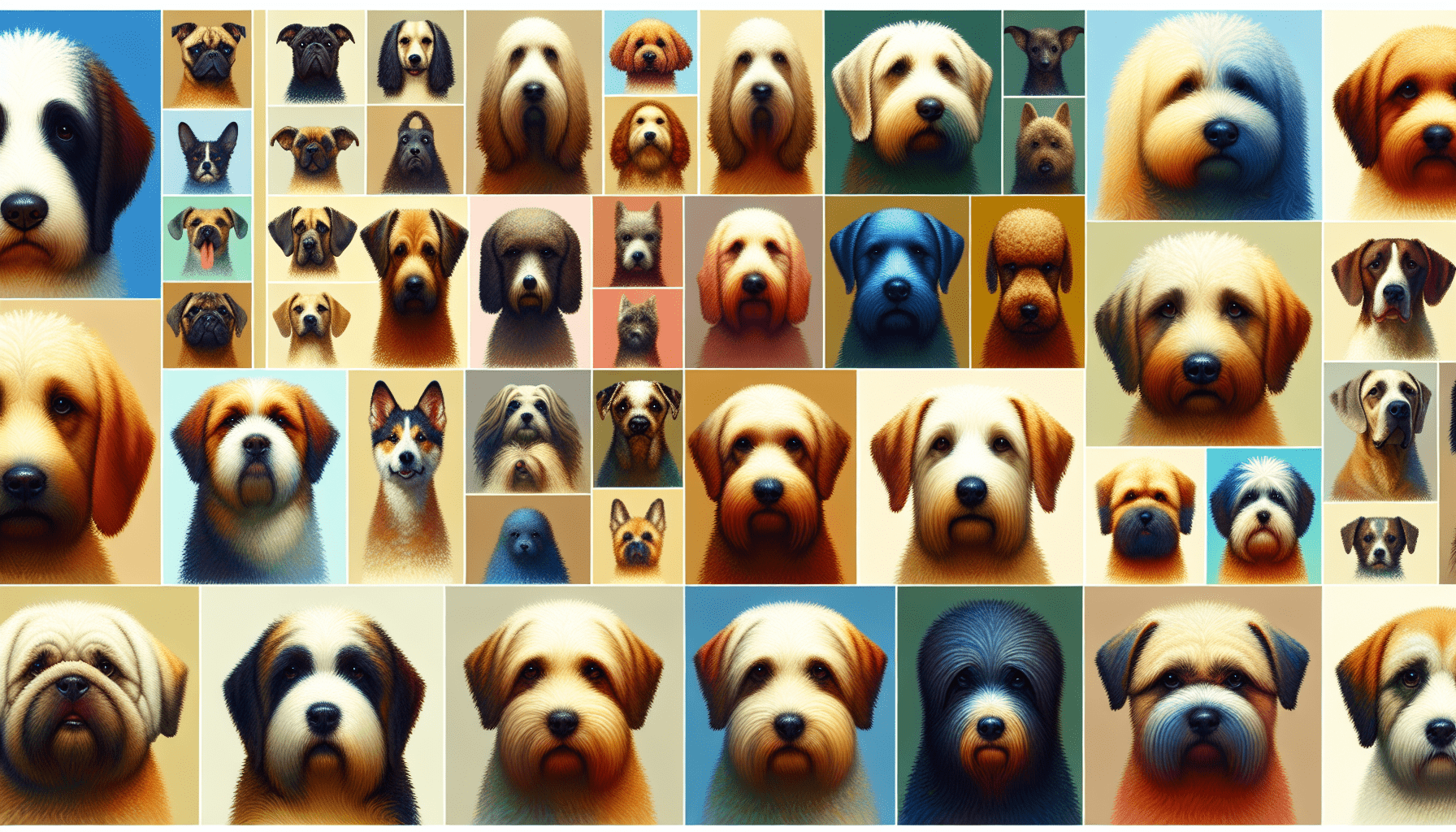Imagine a world where dogs are not just pets, but fashion accessories. A world where Poodles mingle with Labradors and Dachshunds strut their stuff alongside Golden Retrievers. This is the fascinating world of designer dog breeds. These unique mixes, carefully crafted by breeders, have been gaining popularity in recent years. From the adorable Cockapoo to the elegant Goldendoodle, designer dog breeds offer a charming fusion of characteristics from their parent breeds. In this article, we will take a closer look at the world of designer dog breeds and discover why they have captured the hearts of dog enthusiasts everywhere.
What are Designer Dog Breeds?
Definition of Designer Dog Breeds
Designer dog breeds, also known as hybrid dogs or mixed breeds, are a result of intentionally crossing two purebred dog breeds to create a new and unique hybrid. Unlike purebred dogs, designer dog breeds are not recognized by major breed registries, such as the American Kennel Club (AKC), as they are not established breeds with a consistent set of characteristics. These dogs often inherit a combination of traits from both parent breeds, resulting in a wide variety of appearances, temperaments, and behavioral traits.
Origins of Designer Dog Breeds
The origins of designer dog breeds can be traced back to the late 20th century, when breeders began crossing different purebred dogs to create hypoallergenic and visually appealing hybrids. The intent behind hybrid breeding was often to combine desirable characteristics from each parent breed, such as non-shedding coats or friendly temperaments. The first official designer breed was the Labradoodle, a cross between a Labrador Retriever and a Poodle, which was specifically bred to create a guide dog with hypoallergenic qualities.
Popular Designer Dog Breeds
Labradoodle
The Labradoodle is one of the most well-known and popular designer dog breeds. Created by crossing a Labrador Retriever with a Poodle, this breed is often sought after for its hypoallergenic coat and friendly temperament. Labradoodles come in a variety of sizes, ranging from miniature to standard, and their coats can be curly or wavy. They are highly intelligent dogs that require regular exercise and mental stimulation.
Goldendoodle
The Goldendoodle is another beloved designer breed that has gained popularity in recent years. Bred by crossing a Golden Retriever with a Poodle, this breed is known for its friendly, outgoing nature and its hypoallergenic coat. Goldendoodles come in various sizes, including mini, medium, and standard, and their coats can range from straight to curly. They are social dogs that thrive in households with ample love and attention.
Cockapoo
The Cockapoo is a charming and affectionate designer dog breed that is a cross between a Cocker Spaniel and a Poodle. These adorable furry companions are known for their friendly and playful personalities, making them great pets for families and individuals alike. Cockapoos can have curly or wavy coats in a range of colors, and they come in different sizes, from toy to standard. They are highly adaptable dogs that can thrive in both urban and rural environments.

Characteristics of Designer Dog Breeds
Physical Appearance
Designer dog breeds can inherit a wide variety of physical traits from their parent breeds, making them visually diverse and unique. Their appearance can vary depending on the specific mix and the dominance of certain traits. These dogs may have different coat types, colors, and sizes, allowing potential owners to choose a pet that suits their preferences. From fluffy and curly coats to sleek and straight hair, designer dog breeds offer a wide range of options when it comes to physical appearance.
Temperament
Designer dog breeds inherit temperament traits from both parent breeds, which can result in a mixture of personalities. While it is impossible to predict the exact temperament of a designer dog breed, certain characteristics can be common among specific mixes. For example, Labrador Retriever crosses tend to be friendly and outgoing, while Poodle crosses often exhibit intelligence and a desire to please. It is essential to research the temperaments of the parent breeds before choosing a designer dog breed to ensure compatibility with your lifestyle.
Trainability
In general, designer dog breeds are highly trainable due to their mixed heritage. They often combine the intelligence and willingness to please from one or both parent breeds, making training sessions a rewarding experience for both the dog and the owner. However, it is important to note that individual variation exists within each designer breed, and some dogs may require more patience or specialized training techniques. Consistency, positive reinforcement, and early socialization are key to successfully training designer dog breeds.
Advantages of Designer Dog Breeds
Hypoallergenic Qualities
One of the most significant advantages of many designer dog breeds is their hypoallergenic qualities. For individuals with allergies or asthma, these dogs can be a great option as they produce fewer allergens and shed less hair compared to some purebred dogs. Breeds like the Labradoodle and Goldendoodle are known for their hypoallergenic coats, which are less likely to trigger allergic reactions. However, it is important to note that individual sensitivity to allergens may vary, and allergies should be evaluated on a case-by-case basis.
Mixed Breed Benefits
Designer dog breeds benefit from what is known as hybrid vigor or heterosis, a phenomenon where the offspring of two different breeds tend to be healthier, more robust, and less prone to inherited diseases than purebred dogs. This is due to the increased genetic diversity resulting from the combination of different gene pools. While purebred dogs often inherit genetic predispositions to specific health conditions, designer dog breeds may have a lower risk of certain genetic health issues.
Individuality
Designer dog breeds offer individuals the opportunity to own a unique and one-of-a-kind pet. With their diverse physical appearances and temperaments, these dogs stand out from the crowd and can make a personal statement about their owners’ preferences. From the distinctive curly coat of the Labradoodle to the adorable face of the Cockapoo, each designer breed has its own set of characteristics that make them special. Owning a designer dog breed allows you to have a companion that suits your individual tastes and preferences.

Disadvantages of Designer Dog Breeds
Health Concerns
While designer dog breeds often benefit from hybrid vigor, they can still inherit health issues from their parent breeds. It is important to consider that designer dog breeds are not immune to genetic health problems, especially if both parent breeds are prone to certain conditions. Without the extensive breed history and established breeding standards of purebred dogs, it can be challenging to predict or prevent these potential health concerns. Responsible breeders will conduct health screenings and genetic testing to minimize the risk of passing on hereditary diseases.
Cost
Designer dog breeds can be more expensive than adopting a purebred dog from a shelter. The cost is influenced by factors such as the popularity and demand for certain designer breeds, the reputation and experience of the breeder, and the quality of the parent breeds. Additionally, ongoing expenses, such as veterinary care, grooming, and training, should be considered when budgeting for a designer dog breed. It is important to research the average prices and associated costs of owning a designer dog breed before making a financial commitment.
Unpredictable Traits
Due to the combination of traits from different parent breeds, designer dog breeds can exhibit a range of traits that may be unpredictable. While this can add charm and uniqueness to their personalities, it can also make it challenging to determine how a particular puppy will develop as it matures. While breeders may have a general idea of what to expect based on previous litters, there is no guarantee that a designer dog breed will inherit specific traits or characteristics. Prospective owners should be prepared for surprises and embrace the unpredictable nature of designer dogs.
Choosing the Right Designer Dog Breed
Consider Your Lifestyle
When selecting a designer dog breed, it is essential to consider your lifestyle and the specific needs of the breed you are interested in. Some designer breeds require more exercise and mental stimulation, while others may be more suitable for apartment living. Consider factors such as your living situation, activity level, and the amount of time you can dedicate to grooming, training, and socialization. Matching your lifestyle and preferences with the characteristics of a specific designer breed will enhance the overall compatibility and happiness of both you and your furry companion.
Research Different Breeds
Thoroughly research different designer dog breeds to gain a better understanding of their characteristics, care requirements, and potential health concerns. Learn about each breed’s energy levels, exercise needs, grooming requirements, and typical temperament. Additionally, consider the potential challenges or limitations that may arise from a specific breed’s traits. Understanding the breed’s history, purpose, and typical behavior will allow you to make an informed decision and choose a designer dog breed that aligns with your expectations and lifestyle.
Consulting a Veterinarian
Before bringing a designer dog breed into your home, it is advisable to consult with a veterinarian. A veterinarian can help assess your readiness for dog ownership, provide insights into the specific health concerns associated with a chosen breed, and offer guidance on responsible breeding practices. They can also provide information on vaccinations, preventative care, and any breed-specific healthcare considerations. Consulting a veterinarian is an essential step in ensuring the well-being of your new furry friend and establishing a strong foundation for their lifelong care.
Designer Dog Breed Care and Maintenance
Grooming Needs
Designer dog breeds often have varied grooming needs depending on the specifics of their coat type. Some may require regular brushing to prevent matting, while others may need professional grooming to maintain their haircuts. It is important to establish a grooming routine early on to keep their coat healthy and free from tangles or matting. Nail trimming, ear cleaning, and dental care are also important aspects of their grooming routine. Regular grooming sessions not only promote good hygiene but also provide an opportunity for bonding and strengthening the relationship between you and your designer dog breed.
Exercise Requirements
Exercise is crucial for the overall health and well-being of designer dog breeds. The amount and type of exercise required will vary depending on the specific mix and the energy levels inherited from the parent breeds. Some designer dogs may need a daily vigorous walk, while others may require more intense activities such as running or playing fetch. Engaging in regular physical exercise helps to prevent obesity, promotes cardiovascular health, and provides mental stimulation for these intelligent breeds. Tailor the exercise routine to your designer dog’s needs and consult a veterinarian or dog trainer for personalized advice.
Feeding Guidelines
Designer dog breeds have specific dietary needs that should be considered when choosing their food. The nutrition requirements of a particular breed will depend on their size, age, activity level, and any special dietary considerations. Consult a veterinarian for guidance on selecting a high-quality dog food that meets your designer dog breed’s nutritional needs. Proper portion control is important to prevent overfeeding and subsequent weight gain. Additionally, provide fresh water at all times and monitor your dog’s weight and body condition regularly to ensure they are maintaining a healthy weight.
Training and Socialization for Designer Dog Breeds
Basic Obedience Training
Training is essential for all dogs, including designer dog breeds. Basic obedience training provides structure, establishes boundaries, and helps ensure the safety and well-being of your furry friend. Teaching essential commands such as sit, stay, come, and walking on a leash will provide the foundation for a well-behaved dog. Positive reinforcement training methods, which involve rewarding desired behaviors with treats, praise, or play, are highly effective for designer breeds. Incorporate training into daily routines and practice consistency, patience, and positive reinforcement to help your designer dog breed become a well-mannered and obedient companion.
Socializing with Other Dogs
Socialization is crucial for designer dog breeds to develop good behavior and become confident in various situations. Expose your dog to different people, animals, environments, and stimuli from an early age to ensure they become well-adjusted and friendly adults. Allow your designer dog breed to interact with other dogs in controlled and supervised settings, such as obedience classes or dog parks. Positive interactions with other dogs will help them learn appropriate social skills, improve their communication abilities, and reduce the likelihood of behavioral issues. Proper socialization sets the foundation for a happy and harmonious relationship between your designer dog and the world around them.
Positive Reinforcement
Positive reinforcement is a key training method for designer dog breeds. Instead of using punishment or force, positive reinforcement focuses on rewarding and reinforcing desired behaviors. This training approach involves using treats, verbal praise, or play as a reward for good behavior, making the learning process enjoyable for your designer dog. Positive reinforcement builds trust, strengthens the bond between owner and dog, and encourages a cooperative and proactive attitude. Consistency, patience, and a gentle touch are essential when employing positive reinforcement techniques with designer dog breeds.
Designer Dog Breeds and Crossbreeding Controversy
Ethical Concerns
Crossbreeding designer dog breeds has been a topic of debate within the dog breeding community. Critics argue that intentionally mixing breeds can contribute to overbreeding and exaggeration of certain traits in an unhealthy manner. They argue that breeding should focus on preserving purebred breeds and maintaining their health and standards. However, supporters argue that responsible breeding practices can minimize health concerns and that designer dog breeds can offer unique qualities and companionship to owners. It is important for breeders and owners to prioritize the well-being, health, and ethical considerations of these dogs in their breeding practices.
Quality Breeding Practices
Responsible breeders of designer dog breeds prioritize the health and welfare of the dogs they produce. They carefully select parent breeds with complementary traits, conduct appropriate health screenings, and prioritize sound genetic practices to minimize the risk of inherited health issues in the offspring. Ethical breeders also provide a nurturing and enriched environment for the puppies, ensuring they receive proper socialization, veterinary care, and early training. Supporting reputable breeders who follow these practices is essential when considering acquiring a designer dog breed.
Responsible Ownership
Responsible ownership is vital for the well-being of any dog, including designer breeds. Owners should provide a suitable living environment that meets the physical and emotional needs of their designer dog. This includes providing nutritious food, regular exercise, mental stimulation, veterinary care, and grooming. Additionally, responsible owners should invest time and effort into training, socializing, and building a strong bond with their designer dog breed. Owning a designer dog breed is a long-term commitment and requires dedication, love, and responsible decision-making to ensure the best possible life for your four-legged companion.
Conclusion
The world of designer dog breeds offers a diverse array of options for dog lovers seeking a unique and personalized fur companion. These hybrid dogs bring together different breeds, resulting in a wide variety of physical appearances, temperaments, and traits. While there are advantages to owning a designer dog breed, such as hypoallergenic qualities, mixed breed benefits, and individuality, there are also considerations to keep in mind, including potential health concerns, cost, and unpredictable traits.
Selecting the right designer dog breed requires thoughtful consideration of factors such as your lifestyle, researching different breeds, and consulting a veterinarian. Furthermore, understanding proper care and maintenance, training and socialization requirements, as well as the ethical concerns surrounding crossbreeding, is essential for responsible ownership.
As the popularity of designer dog breeds continues to grow, it is crucial to approach this trend with careful consideration and responsible practices. By prioritizing the well-being and health of these unique hybrids, we can enjoy the personal satisfaction and joy that comes with owning a designer dog breed while ensuring a bright future for these furry companions. With continued exploration, we can unlock the potential and endless possibilities offered by the world of designer dog breeds.

